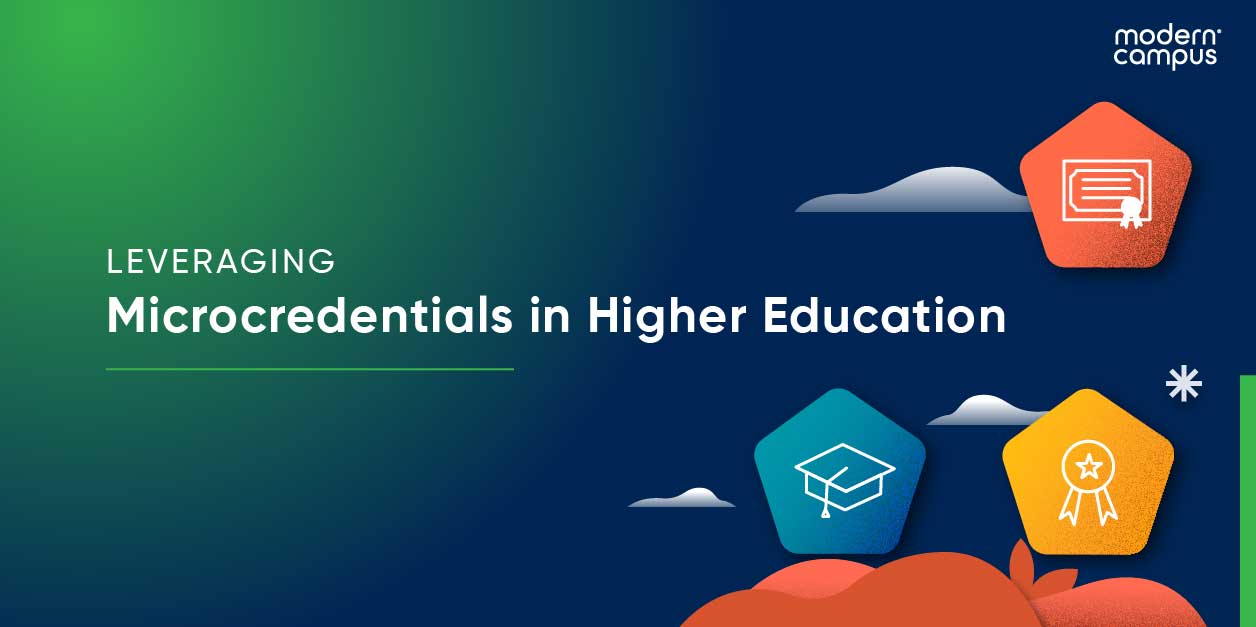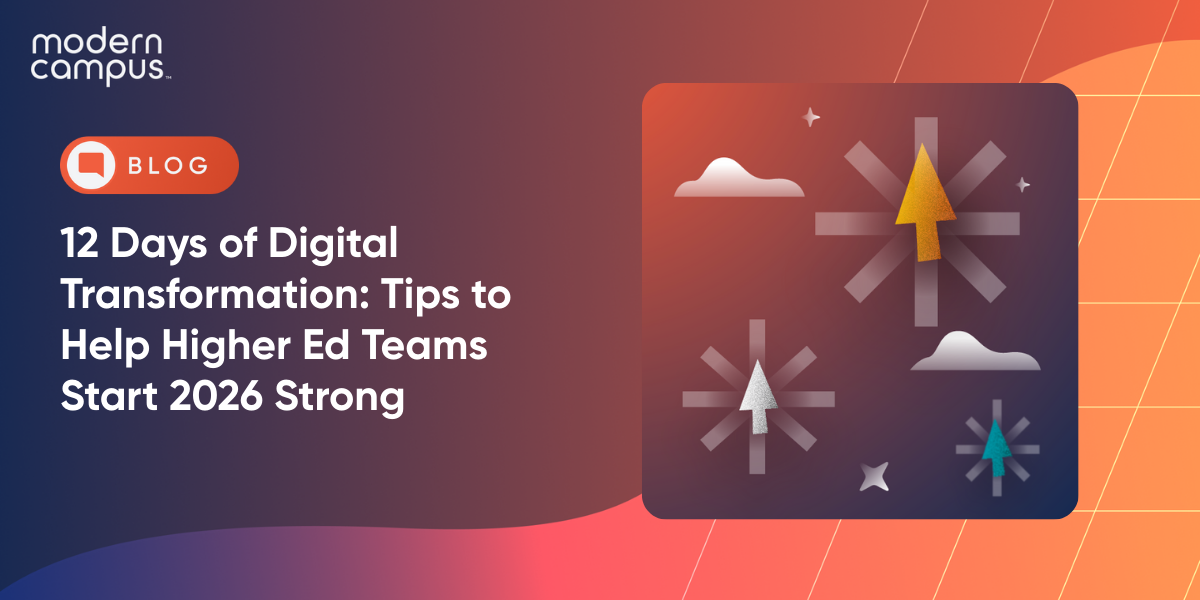Leveraging Microcredentials in Higher Education to Learner Needs
In the past few years, microcredentials and other forms of alternative credentialing have shifted from the shadows into higher education’s limelight. Increasingly, students of all ages are indicating their desire for a revamped postsecondary educational experience.
When it comes to degree-directed programming, 58% of students say they enroll primarily to achieve career outcomes, but 41% of recent graduates wind up underemployed. What’s more, students clearly tie their perception of the ROI of education to career impact. Of recent graduates, 72% of alumni who felt their schools offered strong career support said their student loans were worthwhile, but only 9% of alumni felt the same way after attending schools where they felt career connectivity was lacking.
A 2023 study shows that adult learners are increasingly seeking microcredentials to support their careers. Not only do micro-credentials support employability after graduation; they also support career advancement, filling in gaps of skills that are not recognized by standard higher education pathways.
A recent survey by StraighterLine and UPCEA shows that microcredentials can bring drop-outs back to college.
The writing is more than on the wall for higher education. It’s being projected into the sky through a Bat Signal!
For colleges and universities to stay relevant into the future, it’s critical to find ways to offer students programming and credentials that more seamlessly support their pathways into the labor market.
Importance of micro-credentials
The business leaders of the world have spoken: Reskilling and upskilling their employees is now an essential business practice. And they’re more willing than ever to pay institutions for it.
Your Institution Can Fill the Skills Gap
Employers are experiencing a skills gap that leaves them less competitive in a challenging labor market. Many feel their workers don’t have the right skills for the job or that those specific skills are being outpaced by industry-wide changes.
This is why businesses are looking to Continuing Education and Workforce Development units like yours: The more programming you offer that speaks to their need for flexible, as-needed learning that lets them build on or develop new competency-based opportunities, the more attractive you are as a potential partner.
Executives Want Microcredentials
Alternative and bite-size credentials (AKA microcredentials) are a perfect fit to close the skills gap facing many businesses today. Highly flexible, less expensive, and quick to launch, microcredentials are precisely what these executives are looking for.
These credentials are gaining momentum with learners for similar reasons. Where degree-based learning can be too time-consuming and expensive for many students, microcredentials offer them an alternative path to career success.
Benefits of micro-credentials
Recent data shows that, only 62.3 percent of undergraduate students in the U.S. completed their degree programs within six years of enrolling. Nearly half of students who enroll in a postsecondary education program do not graduate.
For many learners, education must work around their schedules to even be considered as an option. A four-year engagement that asks them to put their professional and personal lives on hold simply isn’t feasible for working learners.
Just-in-time Education Brings in Newcomers
Many of these learners will choose to move towards a degree if allowed to do so in their own time.
This is a gap that microcredentials fill perfectly. When a traditional program is separated to represent its constituent skills, the result is a series of “stackable” credentials and digital badges that add up to the equivalent of a degree. The knowledge and practical skills, and competencies demonstrated are the same—they're just built over a longer period of learning.
The difference this makes for your prospective learner cannot be overstated. Here, the microcredential transforms what is traditionally a once-in-a-lifetime process into an ongoing practice, an education they can opt into and out of as they need. Now, a learner that would’ve never had time for a degree has a path forward.
Shorter Credentials Allow for Smaller, Recurring Payments
There are no two ways about it—unless your learner has limitless income at their disposal, a degree (or even an advanced diploma) can be a massive expense. Balancing personal and family budgets can be hard enough without the tens of thousands of dollars spent on the average degree program in the U.S.
That figure alone can force many learners to opt out of traditional education. Plenty of learners just don’t have the resources to pony up that much at once, and incurring hefty student loans (an average of $37,500 per full-time student in 2020) is not an attractive option for most.
Microcredentials Attract Spending-Conscious Students
A credential that costs less is priceless to your learner. The high price point of a degree is a sticking point for many, no matter how much they value the credential.
By shifting to a more open model of credentialing, learners who would’ve been priced out of enrolling in any program at your institution now have a seat at the table. Some will leverage their more cost-effective credentials to enter your degree-bearing programs, while others may enroll in one or more credentials and be on their way (ones who wouldn’t have enrolled at all, mind you).
In either case, the microcredential positions your institution to serve the modern learner’s needs while expanding your own reach toward new audiences.
How Continuing Education Can Deliver Microcredentials
Flexibility, affordability, and innovation—these are what Continuing Education and Workforce Development units do best.
Google and other free market rangers are only now cashing in on a model that’s been the M.O. of non-credit education for eons. The difference is that Google has prioritized flexible learning modalities and credentials, while many traditional institutions still appear to be on the fence about them.
CE units have a firm grasp on non-traditional education and are more than capable of taking back the lion’s share of the alternative credential market, provided they have the resources to do so.
Non-credit units need support from senior leadership when looking at microcredentials, which requires thoughtful conversation and preparation. But when the value of alternative credentials can be made clear, non-credit units are able to scale their role at the institution while gaining the edge over competing providers.
Marc Austin, who until recently served as Executive Director of Professional Education and Academic Ventures at George Mason University, said the non-credit unit's use of microcredentials has been instrumental in their rise throughout the institution.
“Continuing ed is leading the charge on innovating and changing things in a good way,” Austin said, pointing to George Mason’s use of microcredentials as “the biggest part of that.” He’s found that shorter credentials are attractive to modern learners in ways traditional ones aren’t—giving learners precisely what they’ve been missing from traditional education delivery models.
“In the United States, we have about 36 million adult learners who started school but never finished,” Austin explained. “They're stop-outs, and they have credit. We want to bring them back, but we have a tough time bringing someone back for 120 credits worth of a degree. I have a much easier time bringing them back for a microcredential.”
Austin believes the tools for higher ed’s success are within reach. When alternative modalities are properly prioritized—as Google clearly knows—Continuing Education and Workforce Development are the institution’s secret weapon.
Microcredentials are the Future of Higher Ed
Higher education is fully capable of adapting to the changing needs of its market. Continuing Education and Workforce Development units, in particular, have been doing so for decades now.
All that’s needed to reap the rewards is for institutions to fully embrace the microcredential—the same way their learners are.
In a joint study conducted by Modern Campus, The EvoLLLution and the University Professional and Continuing Education Association (UPCEA), a truly intriguing picture began to form around the state of microcredentialing as it is today, and how it might evolve into the future.
In the report, 92% of higher education leaders indicated that microcredentials support their capacity to compete with emerging entities like bootcamps. Of that, nearly four out of 10 leaders suggested these offerings were either very or extremely effective at differentiating their institution.
What’s more, 88% of leaders said that initiatives to launch new or alternative credentials are aligned with their institution’s strategic plans. More than half of respondents went further to suggest that microcredentialing is either very or totally aligned with their strategic plan.
Finally, more than 70% of higher education leaders responding to the survey said that alternative credentialing initiatives will help them achieve their institutional revenue and enrollment goals.
This paints a clear and exciting picture about the opportunity available to colleges and universities that can capitalize on the need for more granular, work-oriented programming.
To dive deeper into the report’s findings, download Shifting Paradigms: Understanding Institutional Perspectives on Microcredentialing.
Last updated: July 12, 2023




